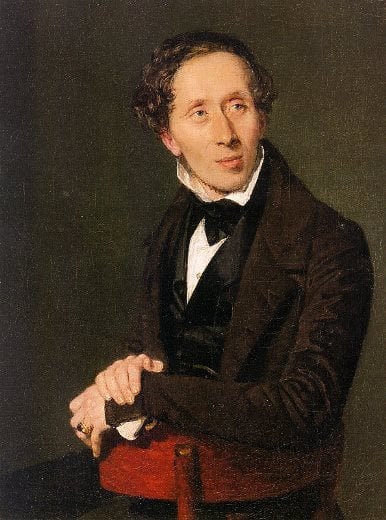 Hans Christian Andersen was a Danish author and poet most famous for his fairy tales. Among his best-known stories are The Steadfast Tin Soldier, The Snow Queen, The Little Mermaid, Thumbelina, The Little Match Girl, The Ugly Duckling, and The Red Shoes.
Hans Christian Andersen was a Danish author and poet most famous for his fairy tales. Among his best-known stories are The Steadfast Tin Soldier, The Snow Queen, The Little Mermaid, Thumbelina, The Little Match Girl, The Ugly Duckling, and The Red Shoes.
During Andersen’s lifetime, he was feted by royalty and acclaimed for having brought joy to children across Europe. His fairy tales have been translated into over 150 languages and continue to be published in millions of copies worldwide.
According to many sources on the Internet and even scholarly books like Corinne Roth Smith’s Learning Disabilities: The Interaction of Learner, Task, and Setting (Boston: Allyn and Bacon, 1991), Andersen had dyslexia.
Early life
Born in 1805 as the son of Hans Andersen, a poor but self-educated shoemaker, and Anne Marie Andersdatter, an illiterate washerwoman, Andersen grew up in the slums of Odense. From 1810-11, he attended two “pogeskoler” (infant schools). After that, his school attendance was somewhat haphazard, especially after his father died in 1816. His mother sent the 11-year-old to work in a tailor’s shop and later a tobacco factory to help support the family. Unhappy with these jobs, he left home at the age of fourteen to seek his fortune in Copenhagen.
As a young teenager, Andersen became quite well known in Odense as a drama reciter and singer. Although determined to become a national success on the stage, Hans failed miserably but made some influential friends in Copenhagen who got him into school to remedy his lack of proper education.
In 1822, Jonas Collin, one of the directors of the Royal Theatre and an influential government official, gave Andersen a grant to enter the grammar school at Slagelse. He lived in the home of the school headmaster Meisling, who was annoyed at the oversensitive student and tried to harden his character. Other pupils were much younger, 11-year-olds, among whom the six years older Andersen was overgrown. His appearance also drew unwanted attention — he had a long nose and close-set eyes.
In 1827, Collin arranged private tuition for Andersen, and he gained admission to Copenhagen University, where he completed his education.
Success as a writer
In 1829, Andersen gained his first success, not as an actor but as a writer, with A Walk From Holmen’s Canal to the East Point of the Island of Amager in the Years 1828 and 1829. Despite its unwieldy travelogue title, this was a tale of fantasy inspired by the work of E. T. A. Hoffmann.
Although today Andersen is primarily known as a writer of stories for children, during his lifetime, he was also celebrated for his other literary works, including six novels, five travel journals, three autobiographies, and numerous poems and plays. According to Terri Windling,
the modern image of Andersen (as portrayed in the sugary 1952 film Hans Christian Andersen, starring Danny Kaye) is of a simple, innocent, child-like spinner of tales, a character from one of his own stories. Letters and diaries by Andersen and his contemporaries, however, draw the picture of a very different man: a sharply intelligent, ambitious writer with a hardscrabble past, a love of high society, and a tortured soul. Likewise, when read in the original Danish (or in good, unabridged translations), Andersen’s fairy tales are far more sophisticated and multi-layered than the simple children’s fables they’ve become in all too many translated editions, retellings, and media adaptations. The writer was no innocent naïf recounting fancies whispered by the fairies; he was a serious artist, a skillful literary craftsman, a shrewd observer of human nature and the social scene of nineteenth-century Denmark.
Allegations of dyslexia “unfounded”
In an article, “Hans Christian Andersen’s spelling and syntax: Allegations of specific dyslexia are unfounded,” published in the November 2000 issue of the Journal of Learning Disabilities, Kihl, Gregersen, and Sterum concluded that Andersen did not have dyslexia. The article is summarized as follows:
Sources contemporary with Danish author Hans Christian Andersen claimed that he did not master the Danish language, which modern studies interpret as specific dyslexia. A systematic study of his diaries from age 20 to age 70 found a mean spelling error percentage of approximately 1.7 (SD = 1%, range = 0%-4%). A methodologically independent reliability study confirmed these figures. Andersen’s error percentages in poems and letters from ages 11 to 19 show a typical initial part of a learning curve that, together with the results from the diaries, gives a life span curve of his spelling development. The diaries, letters, and poems contain only insignificant syntactic errors. Andersen’s spelling in the above studies is compared with that of his contemporaries and with data from modern studies. His mean error percentages at different ages are equal to the figures from non-disabled participants, but between 2 and 15 times lower than the mean percentages in studies of individuals with dyslexia. A structural analysis of Andersen’s spelling errors shows that they are mainly phonologically plausible from ages 11 to 70, and that the proportions of plausible/implausible errors match those of normal achievers, but not those of individuals with dyslexia.
.

